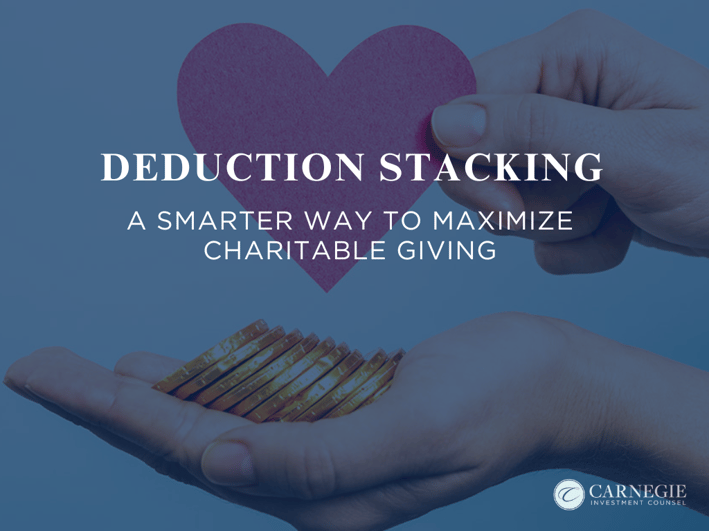With the recent tax bill raising the cap on state and local tax (SALT) deductions from $10,000 to $40,000, a new planning opportunity has opened for high-net-worth individuals and couples. For nearly a decade, many households found themselves unable to benefit meaningfully from itemized deductions. The high standard deduction meant charitable gifts often provided no additional tax benefit. But now, deduction stacking has entered the conversation as a way to maximize both your generosity and your tax efficiency.

From Bracket Stacking to Deduction Stacking
To understand deduction stacking, it helps to first look at a related strategy: bracket stacking. Picture a professional in a high-commission field or an executive with restricted stock units (RSUs). If a large commission payout or vesting event shifts into the following year, their taxable income could spike, bumping them into a higher tax bracket. By planning ahead, "stacking" income in leaner years and smoothing taxable income over time, they can reduce exposure to the highest tax rates.
Deduction stacking takes this same principle and applies it to charitable giving. Let's dive deeper.
Why the Standard Deduction Matters
For 2025, the standard deduction for a married couple filing jointly is $31,500. Unless your itemized deductions exceed that amount, your charitable gifts don’t create any additional tax benefit. While the new law allows for ‘below the line’ deduction of up to $2k for non-itemizers filing jointly, it falls short of the charitable goals for many families. Before the SALT cap was raised, many households hit a ceiling: property taxes plus state income and local taxes deductibility was capped to $10,000. That meant one had to find an additional $21,500 in itemized deductions before their charitable contributions even started to count.
Now, with the cap increased to $40,000, many high-earning households, especially in higher-tax states finally have a chance to break through the standard deduction threshold.
The Mechanics of Deduction Stacking
Here’s where deduction stacking makes a real difference:
- Annual giving example: Suppose a household earning $250,000 gives $10,000 annually to charity. With the SALT deductions (property, state and local taxes), adding up to $25,000, the total deductions after charity are barely above the standard deduction limit. That $10,000 charitable gift ends up being a missed opportunity in this household.
- Stacked giving example: Instead of giving $10,000 every year, the household gives $30,000 once every three years. Adding that lump-sum gift to their SALT deductions pushes them far above the standard deduction. At a 30% plus marginal tax rate, the $30,000 charitable gift generates nearly a $10,000 tax benefit—something they’d miss entirely by spreading the donations annually.
In short, by timing and consolidating charitable contributions, families can unlock deductions that might otherwise go unused. This naturally raises the question of who can benefit the most from putting this approach into practice.
Who Benefits Most?
Deduction stacking isn’t only for the ultra-wealthy. Middle- to upper-career professionals with dual incomes and property in higher-tax regions are often in the sweet spot. For example:
- A two-income household earning $250,000.
- Living in a $600,000 home with 1.5% property tax rate (about $9,000).
- Paying $12,000–$14,000 in state and local income taxes.
This household can easily reach $25,000 in SALT deductions. With stacked charitable gifts, they can leap beyond the standard deduction and reap meaningful tax benefits.
Points to Keep in Mind
- Charitable cadence: Nonprofits may not love the shift from annual to periodic giving. Their cash flow could fluctuate. But in the long run, donors often give more because of the added tax efficiency.
- AGI thresholds: If your adjusted gross income (AGI) exceeds $500,000, itemized deductions will phase out, reducing or eliminating the benefit.
- Contribution limits: Gifts to public charities can be deducted up to 30% of AGI, while gifts to private foundations are capped at 20%.
- Property and local taxes: With the higher SALT cap, it’s worth carefully tracking property and state taxes again. For years, many households ignored these numbers since they provided no tax benefit.
CPA Conversation Starters
The next time you meet with your CPA, ask:
- “How can we use the higher SALT caps to our advantage?”
- “Would bundling our charitable giving in a single year help us exceed the standard deduction and make our giving more tax-efficient?”
- “Can we benefit from electing to use basis of appreciated asset vs fair market value?”
Your CPA should evaluate your charitable giving cadence, your SALT numbers, and model whether consolidation creates additional savings.
Why This Matters Now
The combination of higher property values, elevated state taxes, and the newly increased SALT deduction cap has created an opening that didn’t exist for nearly a decade. Deduction stacking allows households to:
- Maximize the impact of their charitable giving.
- Unlock tax benefits they may have been missing.
- Potentially give more over time, because efficient planning stretches generosity further.
Final Thoughts
Charitable giving is ultimately about supporting the causes that matter most to you. But smart planning can ensure your gifts go further for your favorite nonprofits and your family’s financial well-being. Deduction stacking may not be right for everyone, but for many high-net-worth individuals and couples, it’s a timely strategy worth exploring.
At Carnegie Investment Counsel, we work to uncover strategies like this so you can align your wealth, your values, and your legacy with confidence. Now may be the right time to ask your CPA how deduction stacking could enhance your giving plan.
This commentary is for informational and educational purposes only. Opinions are subject to change.
Carnegie Investment Counsel (“Carnegie”) is a registered investment adviser with the Securities and Exchange Commission. Registration as an investment adviser does not imply a certain level of skill or training. For a more detailed discussion about Carnegie’s investment advisory services and fees, please view our Form ADV and Form CRS by visiting: https://adviserinfo.sec.gov/firm/summary/150488.


